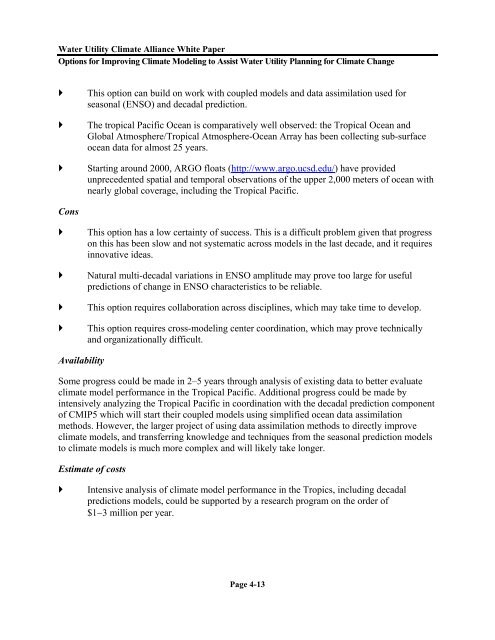Options for Improving Climate Modeling to Assist Water Utility ...
Options for Improving Climate Modeling to Assist Water Utility ...
Options for Improving Climate Modeling to Assist Water Utility ...
Create successful ePaper yourself
Turn your PDF publications into a flip-book with our unique Google optimized e-Paper software.
<strong>Water</strong> <strong>Utility</strong> <strong>Climate</strong> Alliance White Paper<br />
<strong>Options</strong> <strong>for</strong> <strong>Improving</strong> <strong>Climate</strong> <strong>Modeling</strong> <strong>to</strong> <strong>Assist</strong> <strong>Water</strong> <strong>Utility</strong> Planning <strong>for</strong> <strong>Climate</strong> Change<br />
<br />
<br />
<br />
This option can build on work with coupled models and data assimilation used <strong>for</strong><br />
seasonal (ENSO) and decadal prediction.<br />
The tropical Pacific Ocean is comparatively well observed: the Tropical Ocean and<br />
Global Atmosphere/Tropical Atmosphere-Ocean Array has been collecting sub-surface<br />
ocean data <strong>for</strong> almost 25 years.<br />
Starting around 2000, ARGO floats (http://www.argo.ucsd.edu/) have provided<br />
unprecedented spatial and temporal observations of the upper 2,000 meters of ocean with<br />
nearly global coverage, including the Tropical Pacific.<br />
Cons<br />
<br />
<br />
<br />
<br />
This option has a low certainty of success. This is a difficult problem given that progress<br />
on this has been slow and not systematic across models in the last decade, and it requires<br />
innovative ideas.<br />
Natural multi-decadal variations in ENSO amplitude may prove <strong>to</strong>o large <strong>for</strong> useful<br />
predictions of change in ENSO characteristics <strong>to</strong> be reliable.<br />
This option requires collaboration across disciplines, which may take time <strong>to</strong> develop.<br />
This option requires cross-modeling center coordination, which may prove technically<br />
and organizationally difficult.<br />
Availability<br />
Some progress could be made in 2–5 years through analysis of existing data <strong>to</strong> better evaluate<br />
climate model per<strong>for</strong>mance in the Tropical Pacific. Additional progress could be made by<br />
intensively analyzing the Tropical Pacific in coordination with the decadal prediction component<br />
of CMIP5 which will start their coupled models using simplified ocean data assimilation<br />
methods. However, the larger project of using data assimilation methods <strong>to</strong> directly improve<br />
climate models, and transferring knowledge and techniques from the seasonal prediction models<br />
<strong>to</strong> climate models is much more complex and will likely take longer.<br />
Estimate of costs<br />
<br />
Intensive analysis of climate model per<strong>for</strong>mance in the Tropics, including decadal<br />
predictions models, could be supported by a research program on the order of<br />
$13 million per year.<br />
Page 4-13

















